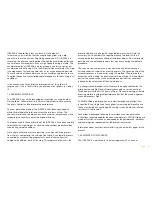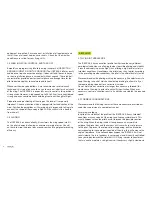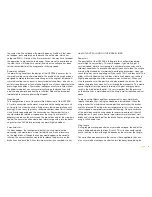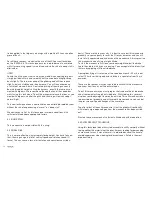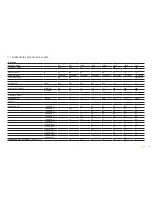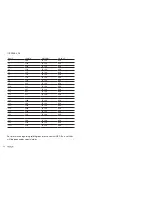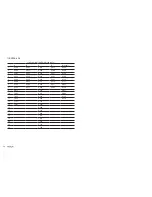
14
a rucksack and in the sunlight temperatures can reach 60ºC. Weight
should not be laid on top of the equipment.
If the flying gear is stored with organic material (such as leaves or insects)
inside, the chemical reaction can cause irreparable damage.
8.3 CHeCKs aNd CoNTrols
We strongly recommend that all actions on the glider were advised for
professionals.
always check all the flying equipment before every flight.
In spite of providing much more benefits to the pilots, 2 liner gliders need
more care and control of the calibration. The ICepeaK 8 mechanic and
UV resistance are one of the highest for this type of line. With a 2 liner
glider every little variation on the calibration of the lines has a directly
effect on the performance of the wing.
We recommend checking the lines calibration after the first 30 hours +/-
of flight. This examination must be taken apart from the regular checking
every 100 hours of use or every two years (whichever happens first).
Why is it necessary?
Thanks to the experience acquired with the 2 liner gliders on the previous
seasons and to the incessant control task of our r&d team over the abac
Team gliders, we are capable now of predicting how to take appropriately
care of this kind of lines to assure the best performance of the profile.
Following the controls recommended the glider will keep its original
features for longer.
The conditions of the flight zone, the climate area, temperature, humidity,
wing load, …cause a different impact over the wing. That’s why the
calibration would be set taking in consideration these factors.
only qualified professionals should realize it. do not modify the wing
considering the calibration required for other pilots before being sure that
it is really necessary for us.
8.4 repaIrs
If the wing is damaged, you can temporarily repair it by using the rip stop
found in the repair kit, so long as no stitches are involved in the tear. any
other type of tear must be repaired in a specialized repair shop or by
qualified personnel. do not accept a home repair.
8.5 lINe replaCeMeNT
The use of new high performance materials in modern wings is now
a reality. The achievements made using these materials in terms of
performance are widely accepted by all as part of the evolution of
our sport. However, along with these advances in technology and
achievements there are added responsibilities which cannot be avoided
The revision and replacement of the lines must now be carried out on
a more frequent basis and that increased frequency appears to be
encouraging many pilots to try and replace the line set themselves.
We sTroNGlY reCoMMeNd THaT aNY lINe replaCeMeNT Is oNlY
CarrIed oUT BY aN aUTHorIsed aNd speCIalIsed persoN.
However that choice is ultimately the responsibility of the pilot and if
the pilot chooses to carry out any line replacement themselves without
guidance from a professional then we suggest the following guidelines are
applied.
Before removing any lines, check:
• That the line plan is correct
• That the lines in the supplied set are present and correct.
• Never assume, check every line individually.
Summary of Contents for ICEPEAK 8
Page 1: ...USER S MANUAL ICEPEAK 8...
Page 22: ...22 11 8 FOLDING LINES PLAN...
Page 28: ...28 11 11 ATTACHMENT POINTS POSITION...
Page 29: ...29 11 12 TENSION BANDS...
Page 30: ...30 11 13 MINIRIBS...
Page 31: ...31 11 14 DIAGONALS...
Page 32: ...32 11 15 INLET SHAPE...
Page 33: ...33 12 CERTIFICATION SPECIMEN TEST ICEPEAK 8 22 ICEPEAK 8 24...
Page 34: ...34 ICEPEAK 8 26...





